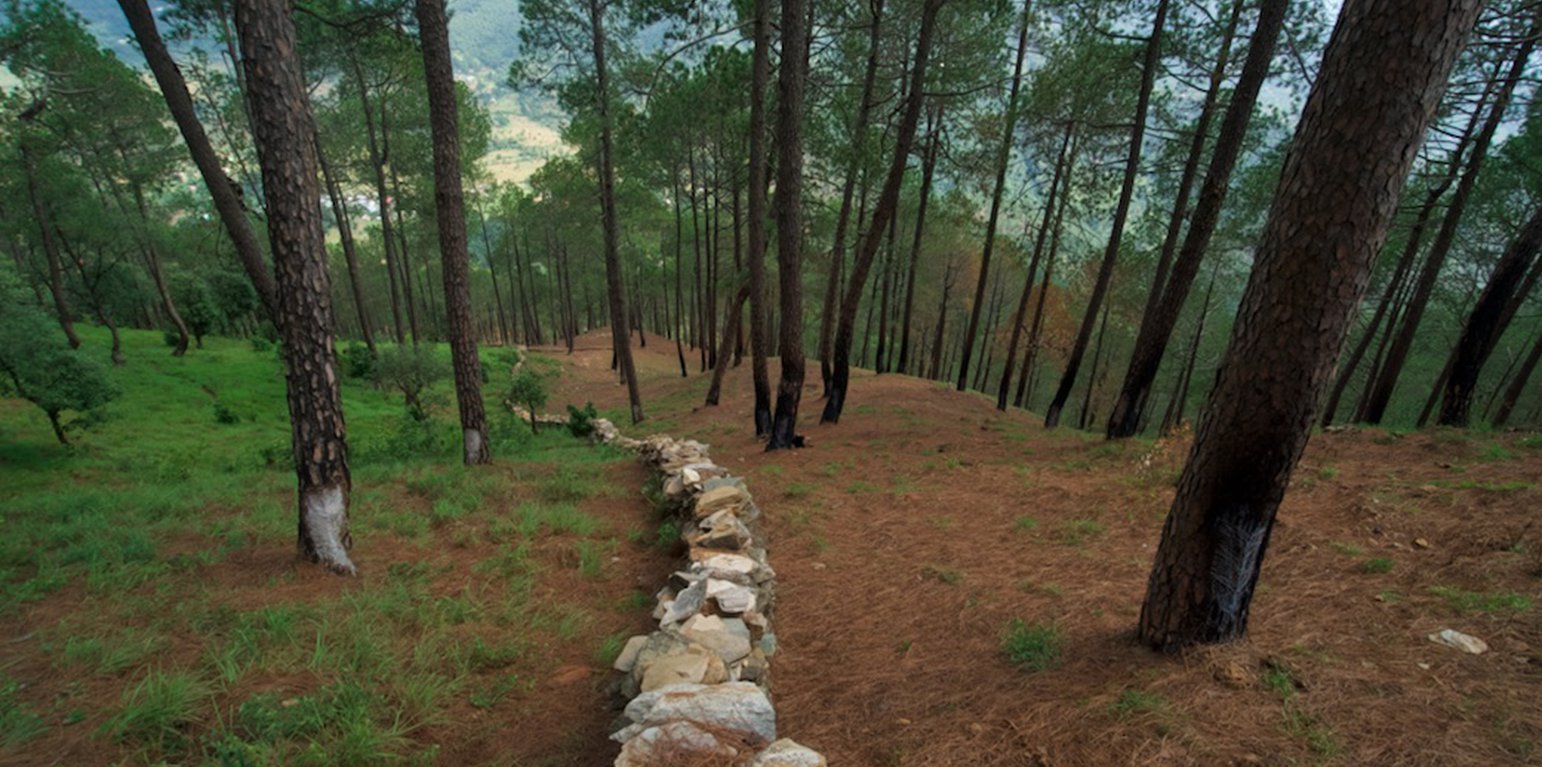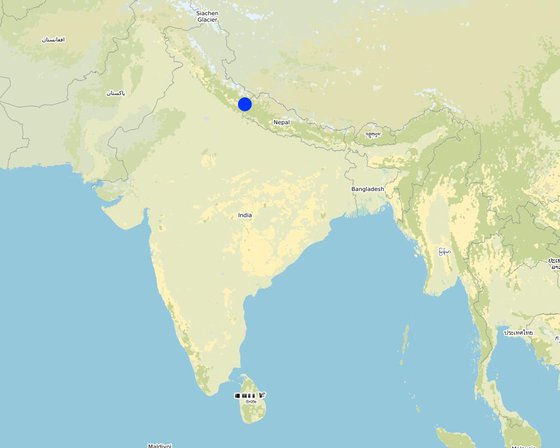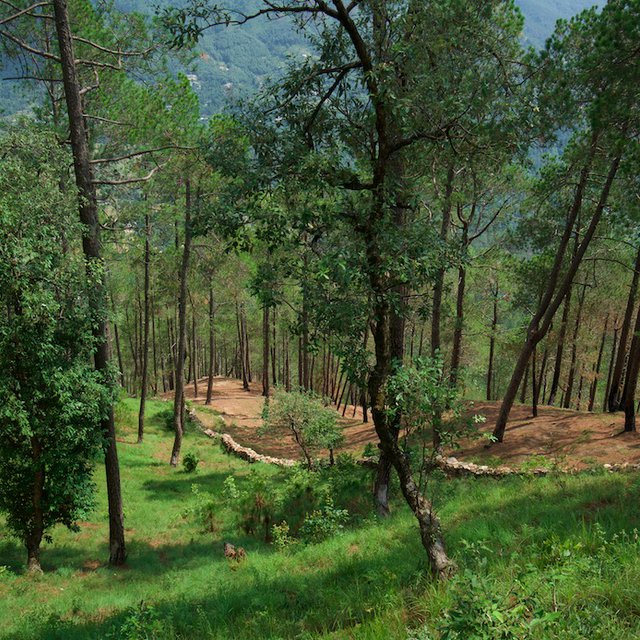



1. The technology has applied in the natural environment (Nakina Van Panchayat)
2. Characteristics of the technology:-
It is a dry stone wall in the community forest.
The wall (3.15km, 1m height, 80 cm width) is 40 years old and is being regularly maintained. The community is currently extending it to 4km.
3. Purpose and function of the technology:-
To protect the forest from forest fires.
To protect the fodder grasses from grazing animals
To protect the community forest from encroachment
To make a margin between two community forests.
4. Major activities and inputs needed to establish and maintain the technology:
Obtaining funding and external support to make the stone wall from other agencies (JICA, Forest Department)
The Forest department and Nakina Van Panchayat were the implementing agencies, and received approval from the District Magistrate to build the wall.
Nakina Van Panchayat organized the community people to construct the wall, paying each person 400 INR ($5.20 USD) a day for their work.
The community pooled their own construction materials and rocks were gathered on site.
5. Benefits and impacts of the Technology:
-Helps to protect forest fires from spreading to the Nakina community forest (physical barrier)
-Protect the fodder grasses from grazing animals
-Avoid conflict between two community forests and deter outsiders from crossing the wall
6. Impacts of the technology:
The wall is successful in protecting the forest from wildfire and it inhibits wildlife/livestock movements or passage.
The people of Nakina village are restricted to a particular area to collect fodder and forest products, which helps them regulate and realize their specific resource demands. This helps them avoid overexploitation of forest resources and set limits.
People views about the technology:-
Like: People are very positive about this technology and they believe that extending its length from 3.15km to 4km will further benefit the forest.
Dislike: The aesthetic of the forest is slightly compromised due to the construction wall.
During construction period, the people realized that some noise pollution from breaking stones could have disturbed neighbors grazing their livestock or other wildlife

الموقع: Naikina Village, Pithoragarh Bloc, Uttarakhand, الهند
عدد مواقع تنفيذ التقنيةالتي تم تحليلها: موقع واحد
انتشار التقنية: منتشرة بالتساوي على مساحة (approx. 0.1-1 كم2)
في منطقة محمية بشكل دائم؟: نعم
تاريخ التنفيذ: منذ 10-50 سنة
نوع التقديم


| الصنف | العدد |
| ماشية - الألبان | غير متاح |
| الماعز | غير متاح |






| تحديد المدخلات | الوحدة | الكمية | التكاليف لكل وحدة (INR) | إجمالي التكاليف لكل مدخل (INR) | % من التكاليف التي يتحملها مستخدمو الأراضي |
| العمالة | |||||
| Unskilled, semi-skilled work (community) | person/day | 4200,0 | 400,0 | 1680000,0 | 100,0 |
| Skilled (technical experts, trained construction workers) | person/day | 50,0 | 2000,0 | 100000,0 | 100,0 |
| معدات | |||||
| Pick | pieces | 15,0 | 300,0 | 4500,0 | 100,0 |
| shovel | pieces | 20,0 | 500,0 | 10000,0 | 100,0 |
| pharuwa (hoe) | pieces | 15,0 | 300,0 | 4500,0 | 100,0 |
| khanti (digging bar) | pieces | 10,0 | 1500,0 | 15000,0 | 100,0 |
| hammer (5kg) | pieces | 10,0 | 2000,0 | 20000,0 | 100,0 |
| chino (chisel) | pieces | 10,0 | 500,0 | 5000,0 | 100,0 |
| Khukuri (knife) | pieces | 10,0 | 250,0 | 2500,0 | 100,0 |
| Small hammer (0.5-1kg) | pieces | 15,0 | 300,0 | 4500,0 | 100,0 |
| إجمالي تكاليف إنشاء التقنية | 1'846'000.0 | ||||
| إجمالي تكاليف إنشاء التقنية بالدولار الأمريكي | 26'371.43 | ||||
| تحديد المدخلات | الوحدة | الكمية | التكاليف لكل وحدة (INR) | إجمالي التكاليف لكل مدخل (INR) | % من التكاليف التي يتحملها مستخدمو الأراضي |
| العمالة | |||||
| Unskilled/semiskilled | person-days | 100,0 | 400,0 | 40000,0 | 100,0 |
| Skilled | person-days | 10,0 | 2000,0 | 20000,0 | 100,0 |
| معدات | |||||
| Picks | pieces | 10,0 | 300,0 | 3000,0 | 100,0 |
| Shovel | pieces | 10,0 | 500,0 | 5000,0 | 100,0 |
| pharuwa (hoe) | pieces | 7,0 | 300,0 | 2100,0 | 100,0 |
| khanti (digging bar) | pieces | 7,0 | 1500,0 | 10500,0 | 100,0 |
| hammer | pieces | 5,0 | 2000,0 | 10000,0 | 100,0 |
| chino (chisel) | pieces | 9,0 | 500,0 | 4500,0 | 100,0 |
| khukuri (knife) | pieces | 5,0 | 250,0 | 1250,0 | 100,0 |
| small hammer | pieces | 15,0 | 300,0 | 4500,0 | 100,0 |
| إجمالي تكاليف صيانة التقنية | 100'850.0 | ||||
| إجمالي تكاليف صيانة التقنية بالدولار الأمريكي | 1'440.71 | ||||
The situation of infrastructure is difficult and inconsistent in the hill regions because of the terrain. The major infrastructural issues are drinking water and irrigation facilities, electricity, transportation and communication facilities and social infrastructure (housing and education). As for financial services, only the State Bank of India (SBI) is active in the hill regions where it is trying to achieve the objective of 100% financial inclusion. Some villages mentioned buying into into agricultural insurance in the past, however this was a temporary enterprise and they were never compensated after extreme climatic events that occurred and damaged over 70% of their crop. Though infrastructure and education has generally improved over the years, institutional and marketing networks in the region aimed at supporting hill-farmers are lacking.
الكمية قبل الإدارة المستدامة للأراضي: 2 ton/hectare
الكمية بعد الإدارة المستدامة للأراضي: 10 ton/hectare
More broadleaf species
Fuelwood from broadleaved species is more plentiful
Less pine encroachment and fire damage, tree lopping for fodder decreased by 15%
Resin collection has increased, pines residing in the protected forest are not damaged by the fire
Rehabilitated areas that had previously been barren or overgrazed
Less dispute over land resources with a clear demarcation
Less damage to plantation and fodder grasses, improved survivability of saplings and decreased costs of supplementary fodder
Decreased fodder availability gap during dry season
Women have saved approximately 1-2 hours in fodder collection
Milk production of the livestock has increased due to improved fodder availability/quality
Improved forest quality and aesthetic of forest surrounding the temple
Increased attention to landscape features and execution of SLM interventions within the community and Van Panchayat
Improved infiltration and soil WHC